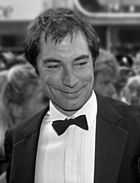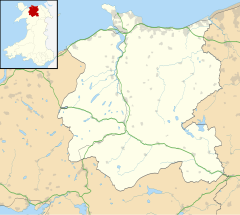|
Colwyn Bay
Colwyn Bay (Welsh: Bae Colwyn) is a town, community and seaside resort in Conwy County Borough on the north coast of Wales overlooking the Irish Sea. It lies within the historic county of Denbighshire. Eight neighbouring communities are incorporated within its postal district. Established as its own separate parish in 1844 with just a small grouping of homes and farms where the community of Old Colwyn stands today, Colwyn Bay has expanded to become the second-largest community and business centre in the north of Wales as well as the 14th largest in the whole of Wales with the urban statistical area, including Old Colwyn, Rhos-on-Sea, and Mochdre and Penrhyn Bay, having a population of 34,284 at the 2011 census.[1] History The western side of Colwyn Bay, Rhos-on-Sea, includes a number of historic sites associated with St Trillo and Ednyfed Fychan, the 13th century general and councillor to Llywelyn the Great. The name 'Colwyn' may be named after Collwyn ap Tangno, an 11th century nobleman who was Lord of Eifionnydd, Ardudwy and part of the Llŷn peninsula,[2] or after the River Colwyn in Old Colwyn. (In Welsh the word Colwyn means "puppy" (with the 'w' being a vowel), but Collwyn (with an alveolar lateral fricative) is a more plausible toponym, meaning "hazel grove" (llwyn cyll).) King Richard II (1367–1400) was ambushed in Old Colwyn in 1399 by supporters of Henry Bolingbroke as he returned to England from Ireland.[3] During World War II the Colwyn Bay Hotel, Marine Road (now demolished) was the headquarters of the Ministry of Food. This also housed the Cocoa & Chocolate division and was the communications hub for the ministry. They continued to use the hotel until 1953.[4] Colwyn also supported the war effort by becoming a significant location for the diamond cutting and polishing industry, which was used to help fund the war effort.[5] The nucleus of the town comprised Old Colwyn (originally Colwyn) and Llysfaen to the east and Llandrillo-yn-Rhos to the west; the town grew up between those two places (which are part of Colwyn Bay for local government purposes). As in the cases of Llandudno and Rhyl, Colwyn Bay grew rapidly in the second half of the 19th century following the arrival of the railway in 1848, and in the early 20th century as a seaside holiday town conveniently for the large towns in NW England. The town was in the historic county of Denbighshire until 1974, and then in Clwyd until 1996. Government Bay of Colwyn Town Council is a statutory body, covering the communities in the urban area. It is based at the old police station and magistrates court, now known as Colwyn Bay Town Hall.[6] The mayor for 2019 to 2020 was Councillor Neil Bastow.[7] Conwy County Borough Council was based at the old civic centre in Colwyn Bay[8] before moving to Coed Pella in Conway Road in Colwyn Bay in November 2018.[9] GeographyThe town is situated about halfway along the north coast of Wales, between the sea and the Pwllycrochan Woods on the towering hillside. Groes yn Eirias (Welsh:Cross in Torch) was once a separate hamlet centred on the Glyn farmhouse (c1640) but the area is now occupied by the Glyn estate and Eirias Park. ClimateLike the rest of the British Isles, Colwyn Bay experiences a maritime climate with cool summers and mild winters, and often high winds. The local climate is well known for the prevalence of Foehn winds: winds from the south which pass over the nearby mountains and warm and dry on their descent, leading to far higher temperatures than might otherwise be expected; the area held the Welsh high temperature record for February at 18.7 °C from 23 February 2012 to 24 February 2019.[10]
DemographyPrior to local government reorganisation on 1 April 1974 Colwyn Bay was a municipal borough with a population of around 25,000, but in 1974 this designation disappeared leaving five separate parishes, known as communities in Wales, of which the one bearing the name Colwyn Bay encompassed just the central part of the overall town and in the 2001 Census contained just 9,742 people, with the others as follows: Mochdre (1,862), Rhos-on-Sea (7,110), Glan Conwy (2,290), Old Colwyn (7,626) and Llysfaen (2,652). This gives a total figure for the six communities of 31,382, generally referred to as the population of Colwyn Bay, making it the 16th largest urban area in Wales and the second largest settlement in North Wales. Bringing 2011 figures into account that figure is now 33,549. The area is sometimes referred to by the name Bay of Colwyn. According to the 2011 Census, 17.9% of the population aged three and above noted that they could speak Welsh.[12] The Census also noted that 29.9% of the population who were born in Wales could speak Welsh.[13] EconomyThe town is dominated by the tourist trade, because of its famous beaches. Colwyn Bay is a Fairtrade Town as certified by the Fairtrade Foundation as part of the Fairtrade Towns scheme. CultureColwyn Bay hosted the National Eisteddfod in 1910 and 1947. Also the Victoria Pier hosted many dances and shows during the 20th century and became popular with touring bands and artistes through the 1960s until the final gig there in August 2008.[14] Community facilitiesThe town has parks and gardens and a number of natural amenities such as Eirias Park. Colwyn Bay has received a gold award 8 times in the Wales in Bloom competition. In 2009 and 2010 the town has been invited to enter Britain in Bloom and has been awarded silver gilt in both years. The Welsh Mountain Zoo is nearby. The Porth Eirias Watersports Centre offers tuition in sailing, windsurfing and power boating as well as kayak and canoe hire. In 2013 it was nominated for Building Design's Carbuncle Cup.[15] Landmarks  The Victoria Pier was closed to the public in 2009, when a dispute between Conwy County Borough Council and the pier's owner led to him being declared bankrupt. The fate of the pier was initially uncertain; the council hoped it would be "substantially" demolished for "health and safety and visual reasons to be able to re-open that section of the beach”.[16] In January 2017, the lower end of the pier partially collapsed into the sea and Conwy Council subsequently announced plans to dismantle and store the pier, with a view of restoring it at a later date.[17][18] The pier was finally demolished in May 2018.[19] Llety'r Dryw is a Grade II listed house in Abergele Road, built for the uncle of Anthony Eden and now used as the training centre for North Wales Police. Llys Euryn is a medieval manor house on Bryn Euryn, now in ruins. There are a number of buildings by notable local architect Sidney Colwyn Foulkes. These include Williams Deacon's Bank 1925 and Colwyn House 1933-7 originally occupied by the W.S.Wood department store.[20] Colwyn Bay Community Hospital was completed in 1925.[21] Cotswold, on Brackley Avenue, is a notable town villa by Alfred Steinthal. Built for a Manchester businesswoman, the house was subsequently the home of Sidney Colwyn Foulkes. It is a Grade II listed building.[22] Its Japanese and Arts and Crafts style gardens are listed, also at Grade II on the Cadw/ICOMOS Register of Parks and Gardens of Special Historic Interest in Wales.[23] Another notable garden is The Flagstaff, overlooking the bay. It was designed by Thomas Hayton Mawson for a house that was not ultimately built, and is listed at Grade II on the Cadw/ICOMOS register.[24] TransportThe town is served by Colwyn Bay railway station located in the town centre on the North Wales Coast Line with trains run by Transport for Wales and Avanti West Coast. The A55 road passes through the town, running parallel to the North Wales Coast Line. TramlineThe Llandudno and Colwyn Bay Electric Railway operated an electric tramway service between Llandudno and Rhos-on-Sea from 1907 and extended to Colwyn Bay in 1908. The service closed in 1956.[25] EducationColwyn Bay has three secondary schools - one private and two state. Eirias High School is in Eirias Park and Ysgol Bryn Elian is in Old Colwyn. Ysgol Bryn Elian mainly serves Old Colwyn and Eirias High School mainly serves Colwyn Bay, Rhos on Sea and Penrhyn Bay. Rydal Penrhos School is a Methodist public school, which is on multiple sites in the town. Fees at this elite public school exceeded more than £34,000 per year for boarding in 2021 and boasts the only Eton Fives courts in Wales. Former alumni include Princess Maria of Romania, a cousin of Prince Charles. The town's primary schools are Ysgol Nant y Groes, Ysgol Pen-y-Bryn, Ysgol T Gwynn Jones, Ysgol Hen Golwyn, and Saint Joseph's R.C. Primary and the Welsh-language Ysgol Bod Alaw. Religious sitesChurches in and around the town include the parish church St Paul's Church, St David's Welsh Church, St John the Baptist's Church, St Joseph's Roman Catholic Church and Christ Church, Bryn-y-Maen to the south of the town. SportThe local football team is Colwyn Bay F.C. who play in the Cymru Premier, the top tier of Welsh football after securing promotion in the 2022–23 season. The local cricket team is Colwyn Bay Cricket Club who play at Penrhyn Avenue and the rugby union team is Colwyn Bay RFC. As of 2012, the RGC 1404 rugby team play at Eirias Stadium in Colwyn Bay as part of a development venture by the WRU. Colwyn Bay Golf Club (now defunct) was founded in 1893. The club and course closed in 1959 and the land was used for a housing development.[26] The Black Cat Cycling Club, founded in 2014, is based in Colwyn Bay[27] with members made up of cyclists from the town and the surrounding area. Glamorgan County Cricket Club traditionally play one first-class game a year at Colwyn Bay.[28] Notable people
Sport
See also
References
External linksWikimedia Commons has media related to Colwyn Bay. Wikivoyage has a travel guide for Colwyn Bay.
|
||||||||||||||||||||||||||||||||||||||||||||||||||||||||||||||||||||||||||||||||||||||||||||||||||||||||||||||||||||||||||||||||||||||||||||||||||||||||||||||||||||





